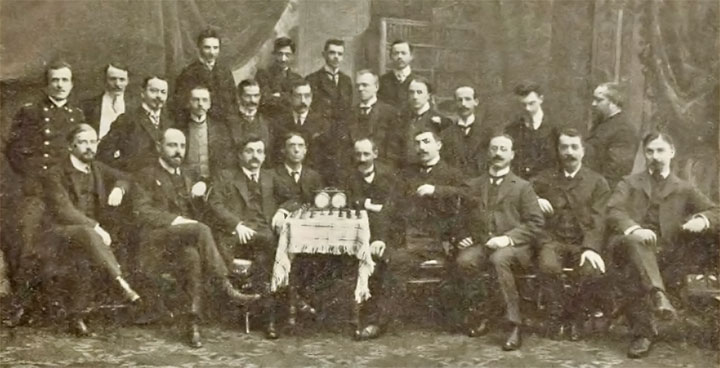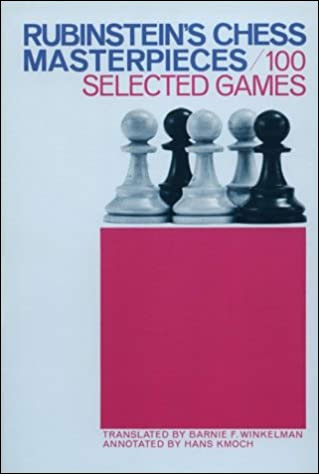The 1909 Saint Petersburg Chigorin Memorial tournament was held in honour of the chess legend Mikhail Chigorin (1850-1908), the founder of the Soviet School. It took part from 14 February to 12 March 1909 and ranks among the greatest chess tournaments of all time. World Champion Emanuel Lasker topped the list of competitors, followed by Akiba Rubinstein, Carl Schlechter, and many other top players of the time: Spielmann, Bernstein, Teichmann, Mieses and Tartakower, to name but a few. The official tournament book, The International Chess Congress St. Petersburg 1909, is still available (in English, with algebraic notation). It was written by Emanuel Lasker, who annotated all 175 games. A 21st-century edition of the tournament book is available in paperback ($13.69) and even Kindle ($8.99).

Saint Petersburg 1909. Seated in the front: Milan Vidmar, Dr Ossip Bernstein, Dr Emanuel Lasker, Amos Burn, Carl Schlechter, Akiba Rubinstein, Jacques Mieses, Georg Salwe, Abraham Speijer. Middle row: Sergey von Freymann, Oldrich Duras, A. M. Levin, S. Znosko-Borovsky, J. Sossnitsky, E. P. Fuerst Demidow San Donato, P. P. Saburow, V. Tschudowski, (last seven tournament committee members), Dr Julius Perlis, Savielly Tartakower, Richard Teichmann. Back row: Erich Cohn, Leo Forgács, Eugene Alexandrovich Znosko-Borovsky (tournament committee), Rudolf Spielmann.
The rounds took place on five days a week, from 11 o'clock a.m. to 9 p.m. with a break from 4 to 6 p.m. The time limit was 2½ hours for thirty-seven moves, then 1½ hours for twenty-three moves, and after that 50 moves an hour. Before the adjournment the player on the move wrote down his move, and gave it to the director in a sealed envelope. Adjourned games were completed on the sixth day (free) day. If the opponents agreed they could also be completed on any evening.

In the final standings, after eighteen rounds, Lasker and Rubinstein tied for first. They each won 875 rubles, Spielmann and Duras got 475 rubles, Bernstein 190 rubles, Teichmann 120 rubles, Perlis 80 rubles, Cohn, Schlechter, and Salwe 40 rubles. All participants received an honorary of 10 rubles for each win and 5 rubles for each draw. A deposit of 10 rubles which the players paid before the start of the event was returned to them if they completed the tournament. Czar Nikolaus donated 1000 rubles and a magnificent imperial porcelaine vase. The total cost of the event, 10,500 rubles, was mostly obtained from voluntary contributions.

 The game we are looking at is the round 17 encounter between Rudolf Spielmann and Akiba Rubinstein. It is dealt with on pp, 60-63 in the book Rubinstein's Chess Masterpieces / 100 Selected Games, by Hans Kmoch, published in 1941 by Horowitz and Harkness. The book is still available on Amazon, in case you are interested. This is how the endgame we are discussing is annotated there (click to enlarge).
The game we are looking at is the round 17 encounter between Rudolf Spielmann and Akiba Rubinstein. It is dealt with on pp, 60-63 in the book Rubinstein's Chess Masterpieces / 100 Selected Games, by Hans Kmoch, published in 1941 by Horowitz and Harkness. The book is still available on Amazon, in case you are interested. This is how the endgame we are discussing is annotated there (click to enlarge).
Kmoch writes: "From the 40th move the ending is a single profound study: Black to play and win,"
It is rumored that after the game finished grandmaster Spielmann shouted: "Akiba, if you lived in the Middle Ages you would have burned at the stake: what you do in rook endgames can only be called witchcraft!"
This is the way Mark Dvoretsky put it in his excellent Endgame Manual. But this endgame is so deep that it seems that almost all published analysis is wrong, if Alex Fishbein and I are right, when we analysed it for the new 5th edition of Dvoretsky's Endgame Manual:

[Event "St Petersburg Chigorin Memorial"] [Site "St Petersburg"] [Date "1909.03.09"] [Round "17"] [White "Spielmann, Rudolf"] [Black "Rubinstein, Akiba"] [Result "0-1"] [ECO "C90"] [Annotator "Mueller,Karsten"] [SetUp "1"] [FEN "1r3k2/5pp1/3p2p1/8/3P4/P6P/2R2P1K/8 b - - 0 40"] [PlyCount "71"] [EventDate "1909.02.15"] [EventType "tourn"] [EventRounds "19"] [EventCountry "RUS"] [SourceVersionDate "2016.11.12"] {Mark Dvoretsky analysed this ending in his excellent Endgame Manual. But it is so deep that it seems almost all published analysis is wrong – if Alex Fishbein and I are right. We analysed it for the new fifth edition of Dvorestky's Endgame Manual:} 40... Ra8 41. Rc3 Ra4 42. Rd3 Ke7 43. Kg3 Ke6 44. Kf3 Kd5 45. Ke2 g5 46. Rb3 f6 47. Ke3 Kc4 48. Rd3 d5 49. Kd2 Ra8 50. Ke2 Ra7 51. Kd2 Re7 52. Rc3+ Kxd4 53. a4 Ra7 54. Ra3 Ra5 55. Ra1 Kc4 56. Ke3 d4+ 57. Kd2 Rf5 58. Ke1 Kb4 59. Ke2 Ka5 60. Ra3 Rf4 61. Ra2 Rh4 62. Kd3 Rxh3+ 63. Kxd4 Rh4+ 64. Kd3 Rxa4 65. Re2 Rf4 66. Ke3 Kb6 67. Rc2 Kb7 68. Rc1 Ra4 69. Rh1 Kc6 70. Rh7 Ra7 71. Ke4 Kd6 72. Kf5 g6+ 73. Kxg6 Rxh7 74. Kxh7 Ke5 75. Kg6 g4 { So your job is: how many decisive mistakes were made by both sides? Which move was Spielmann's last mistake?} 0-1
In our replay board above there are a large number of functions you can use to really understand the game. Recently we published a comprehensive tutorial plus video instructions which tells you about all the powerful features and buttons that make the ChessBase's replay one of the best watching experiences around.
One big advantage is that you can start an engine (fan icon) that will help you to analyse. You can get multiple lines of analysis by clicking the + button to the right of the engine analysis window. The "!" key, incidentally, shows you the threat in any position, which is incredibly useful in the case of unclear moves.
 There is one more thing you can do. It is a lot of fun, but also a serious challenge: Click on the rook icon below the notation window. This will allow you the play the above position against Fritz, at your level of playing strength (e.g. "Club Player"), right here on the news page. Note that your analysis, in which you can delete, move or promote lines, is stored in the notation as new variations. In the end you will find the game with your analysis in the cloud. So nothing is ever lost.
There is one more thing you can do. It is a lot of fun, but also a serious challenge: Click on the rook icon below the notation window. This will allow you the play the above position against Fritz, at your level of playing strength (e.g. "Club Player"), right here on the news page. Note that your analysis, in which you can delete, move or promote lines, is stored in the notation as new variations. In the end you will find the game with your analysis in the cloud. So nothing is ever lost.
Please send any analysis you come up with to me at the following email address: Karsten Müller. You may also like to use more powerful engines to assist you in your efforts. Fat Fritz, for instance, goes for some unconventional continuations and surprises...I will evaluate your submissions and discuss them with you.
Links
.jpeg)




















 The game we are looking at is the round 17 encounter between Rudolf Spielmann and Akiba Rubinstein. It is dealt with on pp, 60-63 in the book Rubinstein's Chess Masterpieces / 100 Selected Games, by Hans Kmoch, published in 1941 by Horowitz and Harkness. The book is still available on Amazon, in case you are interested. This is how the endgame we are discussing is annotated there (click to enlarge).
The game we are looking at is the round 17 encounter between Rudolf Spielmann and Akiba Rubinstein. It is dealt with on pp, 60-63 in the book Rubinstein's Chess Masterpieces / 100 Selected Games, by Hans Kmoch, published in 1941 by Horowitz and Harkness. The book is still available on Amazon, in case you are interested. This is how the endgame we are discussing is annotated there (click to enlarge).
 There is one more thing you can do. It is a lot of fun, but also a serious challenge: Click on the rook icon below the notation window. This will allow you the play the above position against Fritz, at your level of playing strength (e.g. "Club Player"), right here on the news page. Note that your analysis, in which you can delete, move or promote lines, is stored in the notation as new variations. In the end you will find the game with your analysis in the cloud. So nothing is ever lost.
There is one more thing you can do. It is a lot of fun, but also a serious challenge: Click on the rook icon below the notation window. This will allow you the play the above position against Fritz, at your level of playing strength (e.g. "Club Player"), right here on the news page. Note that your analysis, in which you can delete, move or promote lines, is stored in the notation as new variations. In the end you will find the game with your analysis in the cloud. So nothing is ever lost.




